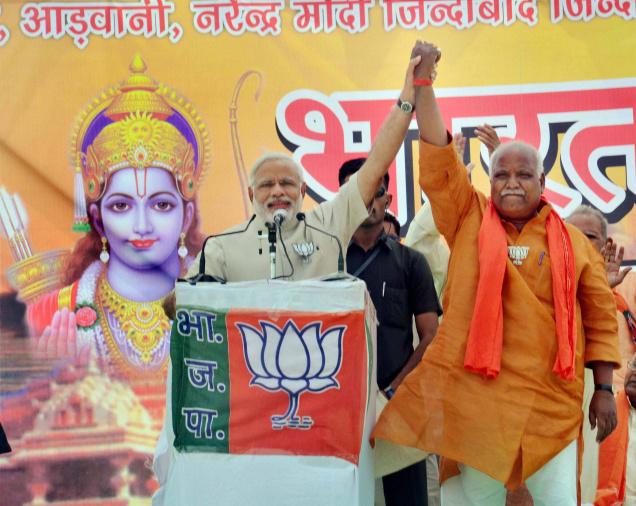 On Sunday evening, young men on motorcycles wearing saffron bandannas and waving Bharatiya Janata Party flags sped through the streets of Faizabad, barely five km from the disputed Ram Janmabhoomi-Babri Masjid site in Ayodhya, urging people to show up in large numbers to hear the party’s prime ministerial candidate, Narendra Modi, on Monday.
On Sunday evening, young men on motorcycles wearing saffron bandannas and waving Bharatiya Janata Party flags sped through the streets of Faizabad, barely five km from the disputed Ram Janmabhoomi-Babri Masjid site in Ayodhya, urging people to show up in large numbers to hear the party’s prime ministerial candidate, Narendra Modi, on Monday.
Mr. Modi, when he arrived here, made a calibrated pitch: he didn’t promise to build the Ram temple as his aide and party general secretary Amit Shah had announced last July when he visited Ayodhya. Instead, he stood on a stage that had a poster of Lord Ram as its backdrop. As the battle cry of the 1990s — “Jai Shri Ram” — rent the air, he said, “I promise on this land of Lord Ram that I will fight corruption all my life.”
The message had a Ram Mandir connotation for the BJP supporters as it came on the back of two big incidents: first there was communal violence in end-2012 in Faizabad, an area that saw little tension even at the height of the Ramjanbhoomi movement in the early 1990s; next on February 7, 2013, the Vishwa Hindu Parishad’s steering committee — in consultation with the Rashtriya Swayamsevak Sangh — passed a resolution on the construction of the Ram temple at the Kumbh Mela in Allahabad, apparently in the hope that the revival of the issue would help the BJP politically in the 2014 elections.
Indeed, conversations with the locals in Faizabad confirm that this build-up has propelled the BJP’s candidate, Lalloo Singh, into a position of advantage. “Lalloo Singh failed to win the Faizabad Lok Sabha seat in 2004 and 2009. In 2012, he even lost the Ayodhya Assembly seat that he held since 1991,” says Brijesh Singh, a local transporter, adding, “but now, thanks to the communal riots in 2012 and the Modi wave, he is ahead of his two closest opponents — the Congress’s sitting MP Nirmal Khatri and the Samajwadi Party’s Mitrasen Yadav.”
The battle for the constituency’s Muslim vote is now between Mr. Khatri and Mr. Yadav. But with the communal violence of 2012 succeeding in breaking the Yadav-Muslim social alliance here (just as Muzaffarnagar destroyed the ties between Jats and Muslims across western U.P.), the failure of the SP government to compensate affected members of the community has resulted in the minorities veering towards Mr. Khatri, according to local Muslims.
“Those Muslims whose shops were burnt were promised compensation,” says a local Muslim activist Gufran, “but when it arrived, it was a fraction of what the government had committed itself to giving. The Hindus also became hostile to Muslims because of all the government’s announcements that it was helping the community. Now, the Muslims want to teach the Samajwadi Party a lesson.”
On the surface, the BJP candidate is most advantageously placed, thanks to the spike in the Hindutva quotient here. But opposition within the party to Mr. Singh’s candidature has provided a twist in the tale. Vinay Katiyar, who was the BJP MP from Faizabad in 1991, 1996 and 1999, wanted the ticket for his protégé and Rudauli MLA Ramachandra Yadav. A miffed Katiyar is now working against Mr. Singh, say BJP insiders here. And Mr. Ramachandra Yadav is “helping” the SP candidate, who belongs to his community.
For Mr. Modi, getting Lalloo Singh through in Faizabad will be a test of the “wave” he has generated across Uttar Pradesh. It remains to be seen whether his rally here on Monday will wash away the hostility to the BJP candidate here.





